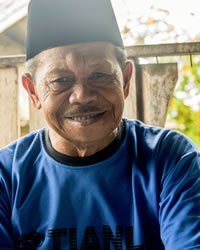Kaimbulawa in Indonesia

Photo Source:
Copyrighted © 2026
Anonymous All rights reserved. Used with permission |
Send Joshua Project a map of this people group.
|
| People Name: | Kaimbulawa |
| Country: | Indonesia |
| 10/40 Window: | Yes |
| Population: | 2,900 |
| World Population: | 2,900 |
| Primary Language: | Kaimbulawa |
| Primary Religion: | Islam |
| Christian Adherents: | 0.17 % |
| Evangelicals: | 0.17 % |
| Scripture: | Translation Started |
| Ministry Resources: | No |
| Jesus Film: | No |
| Audio Recordings: | No |
| People Cluster: | Bungku-Bajau |
| Affinity Bloc: | Malay Peoples |
| Progress Level: |
|
Introduction / History
The Kaimbulawa people live in four villages in Southeast Sulawesi: Kaimbulawa, Waidawula, Lontoy and Karae. The Kaimbulawa consider themselves descendants of a commander of the Buton kingdom named La Saompula. After waging war with the Banggai kingdom, he returned and placed the head of the defeated Banggai king on the reef on the beach of Kaimbulawa village and lived there.
What Are Their Lives Like?
Most Kaimbulawa make their living in agriculture; although their area is close to the sea, only a small percentage are fishermen. The Siompu orange - a uniquely flavorful, rare, and expensive orange - highlights their crops. The trees bear fruit only once a year and often die without bearing any fruit.
Tribal life centers around the baruga, a tribal gathering place used for various purposes. Council meetings held at the baruga include the annual meeting and court proceedings. The annual meetings provide village boundary markers aimed at preventing troops from entering this area and preventing violations of the established limits.
A Kaimbulawa village is led by a cultural chief and his assistants and a religious leader. The cultural chief and religious leader work together in deliberations. Every cultural event is attended by the religious leader and every religious meeting involves the cultural chief.
If one of the people commits a crime but does not confess to it after a council at the baruga, they will die after three days. If they confess, they will be fined. The fine might consist of giving food to others in their village or walking through the village shouting the nature of their crime, as a deterrent to repeating the offense.
What Are Their Beliefs?
The Kaimbulawa converted to Islam within the last couple of generations and, as a result, Islam is not yet deeply rooted. During Ramadan (the fasting month), the mosques appear to be mostly empty at prayer times; very few are attending.
What Are Their Needs?
A small people group, the Kaimbulawa would benefit from modernization of agriculture, education and medicine that would still leave their culture intact.
Prayer Points
Ask Jesus to appear in dreams and visions to leaders in the Kaimbulawa villages and to reveal himself as the true Son of God.
Ask the Holy Spirit to show the Kaimbulawa the futility of attempting to earn salvation through works.
Pray for God to send workers to the Kaimbulawa to proclaim the gospel and translate the Bible into their language.
Pray for Kaimbulawa disciples to make more disciples.